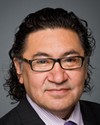Thank you very much, Mr. Chair. Thank you for having us.
Today I'd like to provide an overview of Indigenous and Northern Affairs Canada's mandate, its responsibilities, organizational structure, and key priorities for the 2016-17 years.
Before I begin, I would note that I am also tabling a presentation entitled “Main estimates 2016-2017” for your information. The presentation contains the department's financial context and expenditure information. While I won't speak to this presentation today, Paul Thoppil, the chief financial officer, would be pleased to respond to your questions.
INAC's minister oversees a complex and challenging portfolio and provides leadership on the Government of Canada's relationship with indigenous peoples and its responsibilities in the north. The department has a dual mandate: indigenous affairs and northern affairs. In some cases there's overlap between the two areas, but as often as not the two are separate.
The minister's mandate is derived from a number of statutes. Of particular note, the Department of Indian Affairs and Northern Development Act outlines the powers and duties of the minister and the department. While the term “Indian” remains in the department's legal name because of this act, the term “indigenous” is now used in the department's applied title under the federal identity program.
Section 35 of the Constitution Act, 1982 recognizes and affirms existing aboriginal and treaty rights, and section 91(24) of the Constitution Act gives the federal department exclusive legislative authority over “Indians, and Lands reserved for the Indians”.
The department's mission is to work to make Canada a better place for indigenous and northern people and communities. We work towards this by promoting reconciliation and fulfilling our constitutional and legal obligations to indigenous peoples. We work to improve quality of life and to support and enable indigenous peoples' participation and inclusion in Canada's economy.
In general, INAC has primary but not exclusive responsibility for meeting the federal government's constitutional treaty, political, and legal responsibilities to indigenous peoples and northerners.
The presentation before you outlines INAC's key objectives as well as a comprehensive listing of responsibilities and activities. These include engaging in dialogue with indigenous peoples about rights that have yet to be recognized or established; negotiating comprehensive and specific claims and self-government agreements, and implementing related obligations; implementing the Indian Act, which remains the primary vehicle for exercising federal jurisdiction under 91(24) and the Constitution Act, 1967 which guides how the minister interacts with first nations; implementing approximately 93 other statutes covering a wide range of subjects and responsibilities; and supporting the minister as the Government of Canada's primary interlocutor for Métis and non-status Indians.
INAC also funds the delivery of programs and services for first nations on reserve as a matter of policy, including provincial and municipal-type programming and services such as education, social housing, emergency management, and community infrastructure, often in partnership or through memoranda of understanding with provinces and territories. It is important to note that indigenous peoples residing off reserve have full access to provincial social and education programming. This context points to the need to work closely with provincial and territorial governments in developing solutions to issues facing indigenous peoples.
INAC also supports indigenous participation and inclusion in Canada's economy through entrepreneurship and community economic development programs; indigenous involvement in natural resource development and management, such as participation in commercial fisheries; key opt-in legislation, such as the First Nations Land Management Act; and indigenous labour force readiness in participation activities.
Through its northern development mandate, INAC leads federal government efforts for two-fifths of Canada's land mass, with a direct role in advancing the Northern Strategy through the political and economic development of the territories and significant responsibilities for science, land, and environmental management. In the north the territorial governments generally provide the majority of social programs and services to all northerners, including indigenous people; however, INAC serves as a focal point for Inuit issues and supports the inclusion of Inuit-specific concerns in federal program and policy development.
My presentation provides some information on the terminology used to refer to indigenous peoples today, as well as some brief demographic information on the populations we serve in executing INAC's mandate and responsibilities.
The term “aboriginal peoples” refers to the descendants of the original inhabitants of North America. The Constitution Act 1982 recognizes three groups: Indian, Métis, and Inuit. There are three separate peoples with unique heritage, languages, cultural practices, and spiritual beliefs.
The term “indigenous” is similar to aboriginal, in that it refers to all three status groups in Canada: first nations, Métis, and Inuit. Indigenous is used in the international context and is the preferred term in English. Both terms translate into French as autochtone.
The term “status Indian” refers to a person registered as an Indian under the Indian Act, while “non-status Indian” refers to an Indian person who is not registered as an Indian under the act.
There are legal reasons for the continued use of the term “Indian”. Such terminology is recognized in the Indian Act and is used by the Government of Canada when making reference to the particular group.
“First nations people”, though, is the term that refers to Indian peoples in Canada both with and without status under the act. Some communities have adopted the term first nations rather than band.
“Inuit” are indigenous people in northern Canada living primarily in Nunavut, the Northwest Territories, northern Quebec, and northern Labrador. “Métis” refers to the people of mixed first nation-European ancestry who identify as Métis.
In terms of demographics, about half of the registered Indians live on reserves, with the majority of non-status Indians and Métis living in urban centres.
INAC's program alignment architecture or PAA is an inventory of all the programs undertaken by the department for systematic reporting, from main estimates to Public Accounts. The PAA forms the backbone of each department's report on plans and priorities. Planned performance in regard to financial resources, human resources, and program results are articulated at all levels in the PAA.
INAC's 2016-17 PAA is organized by four strategic outcomes and is supported by 15 departmental programs and 37 subprograms. The four strategic outcomes are: the government, which supports good governance rights and interests of indigenous peoples; the people, which addresses individual, family, and community well-being for first nations and Inuit; the land and economy, which addresses full participation of first nations, Métis and non-status Indians, and Inuit individuals and communities in the economy; and the north.
The program alignment architecture illustrates how the work of the department has been organized in the past. This structure will be used with minor changes for the upcoming year, and will be revisited for future years.
To deliver on its responsibilities, the department is organized into nine sectors that provide services for Canadians. Key activities of each sector are referenced in my presentation. All of their activities support and align with the department's four strategic outcomes.
As well, INAC has 10 regional offices and one special operating agency, Indian Oil and Gas Canada. The regional offices are critical to the work of the department. They support the effective delivery of the wide range of programs, activities, and services that the department undertakes. They maintain direct links with the communities we serve and with the provincial and territorial governments and other partners. Although INAC's mission and objectives are similar from region to region, the economic, social, and cultural profile of indigenous peoples is diverse and varies across and within regions.
In addition, five corporate service functions support departmental activities through the provision of communication services, human resources and workplace services, audit and evaluation, corporate secretariat functions, and legal services.
It is becoming increasingly important for the sectors to work together to implement the department's priorities, just as different departments across the federal government need to come together to support government-wide priorities.
Here, on page 11, we have provided you with some information on how departmental staff are distributed across regions and headquarters. The proportion of staff in each region generally corresponds to the relative size of the indigenous population in each region.
Concerning the current direction, we have provided an overview of key indigenous northern commitments that have been articulated in Minister Bennett's mandate letter and the Speech from the Throne. These commitments are what will guide INAC over the next four years. Tabled in the House of Commons on March 22, budget 2016 also announced historic investments totalling $8.4 billion over five years to implement the commitments. Proposed investments in education, infrastructure, training, and other programs will be implemented in collaboration with a number of other departments.
For the purposes of INAC's report on plans and priorities, the department has translated these commitments into five major cross-cutting themes: moving forward with rights and reconciliation; putting children and youth first; supporting stronger indigenous communities; improving quality of life for Métis, individuals, and communities; and fostering a strong and inclusive north.
All of the priorities are horizontal in nature and will require co-operation with other federal departments, with provinces and territories, with municipal governments, and, most importantly, with indigenous communities and organizations.
Just to conclude, INAC has a leading role on behalf of the federal government in advancing the reconciliation agenda and the nation-to-nation relationship with indigenous peoples, as well as a direct role in advancing the northern strategy through political and economic development.
The roles are wide ranging and they're constantly evolving. We're trying to do everything with a sense of partnership.
With that, I'll conclude and take your questions.












